Thinking of revamping your kitchen? You’re not alone.
Would-be movers, thwarted by high interest rates and a lack of homes for sale, feel stuck.
Tired of the “will we, won’t we?” loop, many are deciding to stay put and invest, and a new kitchen is top of their list. Indeed, home improvement loans are up by almost 27 per cent year on year, according to Banking & Payments Federation Ireland (BPFI) figures.
“People are saying, will you come to my house?” says Dave Fagan, director at Kube Kitchens, adding that they then say, “we just need to actually decide, are we keeping the house?
Dancing with the Stars: ‘I’ve had the best time of my life. I feel super fit,’ chef Kevin Dundon says as he is voted off show
Oscars 2025 red carpet: Ariana Grande sets the standard while Timothée Chalamet stood out in ‘Kerrygold’ yellow
Róisín Ingle puts a Thermomix to the test: ‘I am a convert but there’s one enormous catch’
Life without children: ‘I’d want the investment my mother had, but I don’t have it in me. I don’t have the grá for it’
“Every day of the week, customers are saying, we’ve decided to stay, we’re taking out a loan, we just need to make the downstairs work better.”
So, if you’re one of the ones spending on your kitchen in 2024, here are the trends to watch.
Modern country
Has “country” become a dirty word in kitchen styles? Viewers of Grand Designs, Room to Improve and Home of the Year will be used to seeing architects wince at bulky cabinetry, stone sinks and Victoriana taps.
An ultra-sleek, minimalist kitchen might be what the architect wants, but it leaves some homeowners cold. Enter what Kube calls its “transitional” range.
“It’s literally becoming a thing where customers are happy to have a mishmash of ultra-modern and country. They will say, ‘I hate country style. My house is not country style, but I am also not ultra-modern,’” says Fagan.
“It’s a case of having a shaker-style door and a mixture of modern work surfaces. We call it the ‘transitional range’, a blend between classic and modern.” Minimalists – cover your eyes.
Texture and warmth
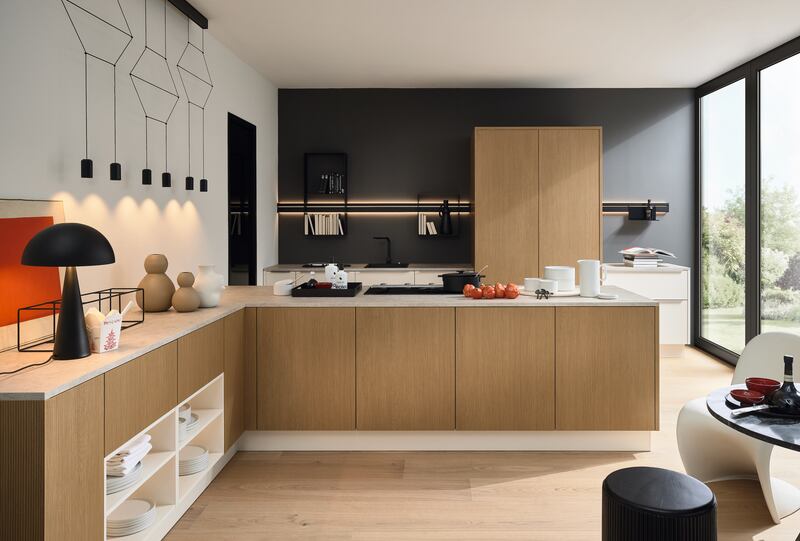
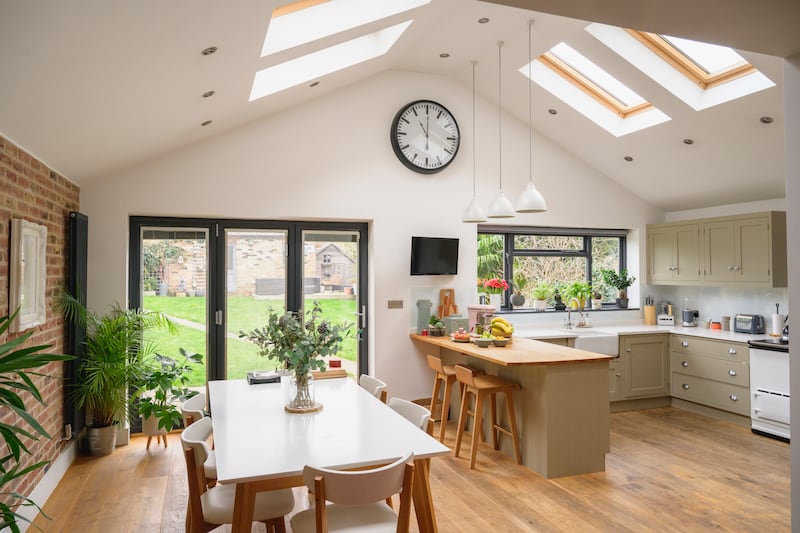
Minimalist, handleless kitchen cabinetry have dominated interior design magazines in recent years. This year sees a return to a bit more texture and warmth, says Fagan.
Integrating a natural material such as oak adds warmth and softness to a kitchen and contrasts with sleek surfaces, he says. It can be used as a full worktop or section of it, a block of cabinets or in recess panels and shelving. It can work well when blended with white cabinets and worktops.
Ridged or grooved doors are cropping up too. “Customers are looking for texture. They want tactile surfaces, they don’t really want high-gloss or marble effect. Grooved doors can work really well on one area of the kitchen, such as an island or tall unit,” he says.
Minimalism is receding, says architectural designer Courtney McDonnell of Courtney McDonnell Studio. “People are moving away from completely handleless kitchens. I think people want a little bit more interest in their kitchen, and maybe more tone and texture, so something like a handle on some units, like your tall fridge-freezer or pantry-type units, people like to bring a handle in now.”
A splashback in something earthy such as a clay tile adds interest and will complement the stone on a countertop. “Something that’s not all very samey-samey,” she says.
Au naturel
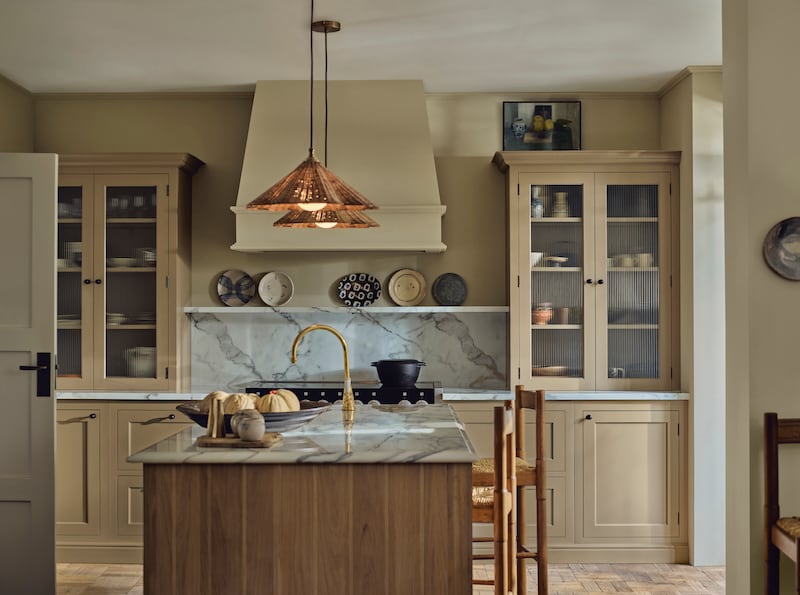
There’s a move away from coloured kitchens, says McDonnell. “Injecting colour into your kitchen cabinets is kind of a bold move. It’s such a big part of your house. When you are making a statement with your kitchen, you may tire of it and it’s harder to change,” says McDonnell.
Customers are embracing more natural finishes that have a timeless feel. “Polished concrete is now very popular for kitchen flooring and countertops. We are doing a lot of oak kitchen joinery too,” says McDonnell.
Appliance storage
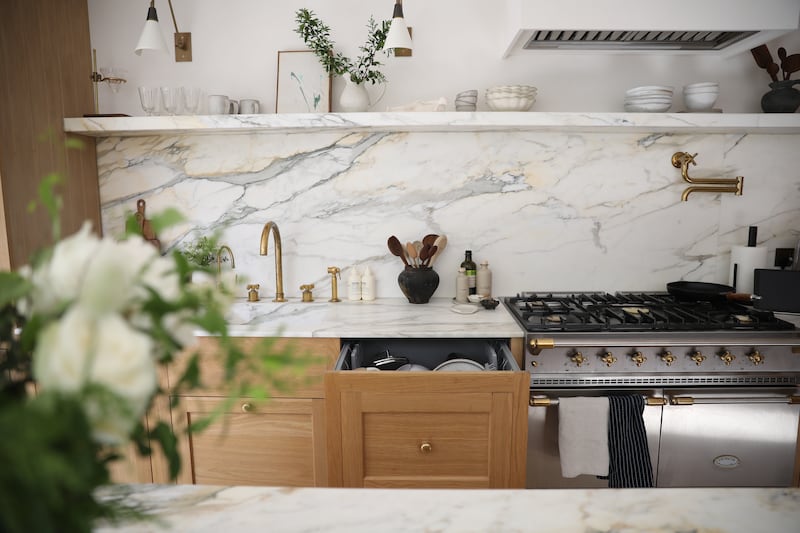
Kitchen tech has exploded and homeowners want all of it – except they want it out of sight, says Fagan.
“Everybody now has an air fryer, a Thermomix, a juicer – people are really investing in how they cook at home,” he says. “But they are making sure the counters are clean and everything can be put away when it’s finished.” Trailing power cords, begone.
That means more accessible storage or an appliance cupboard. “People send us pictures with every single measurement – ‘These are the sizes of my five appliances. I need them hidden behind doors or in drawers so that when I want to take them out, it takes a second.’ They want them out of sight,” says Fagan.
Those with an enviable amount of space want an appliance pantry. “It’s a separate room to the kitchen, with a worktop, a prep sink, and all of their stuff is on display – that’s where they go and make all the mess, put on the slow cooker, put on the Ninja grill and they come back out to the kitchen where they barely use their ovens,” says Fagan.
Fewer cabinets

There is a move away from having a full bank of overhead cabinets, says McDonnell. Big islands are solving storage issues, so open shelving over counters is becoming more popular. “It gives you a way to display your personality, things you have collected or glassware you might own,” says McDonnell.
“You are not seeing so many heavy units overhead. Things are more open, like you might see in a bar scenario.”
Desert island
Having seats around an island used to be the whole point – now there’s a shift by some towards a designated dining space, says McDonnell. “A lot of people want a really gorgeous dining area, or built-in booth seating. The knock-on effect is not everyone is going for seating around the island. The island is now becoming its own feature as a secondary prep or cooking space only.”
Raise the bar
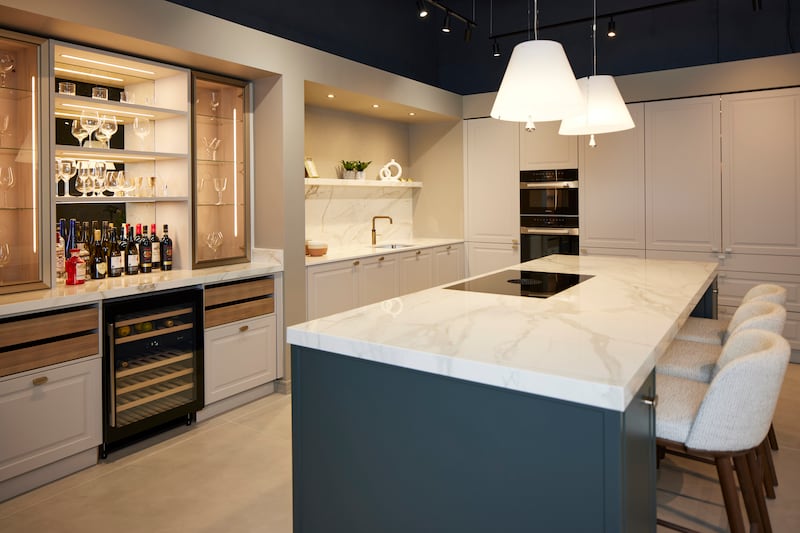
A wine fridge used to be pretty fancy, but the trend of built-in bars takes things up a notch. “My last two kitchen sales would have had bars built in to them,” says Fagan. “It’s not just a wine cooler, it’s glass units, open shelving and clever lighting.”
Glass-fronted cabinets have your glassware and range of spirits on display; mirrored backs add extra light and sparkle. A wine fridge can be installed underneath. Some are relocating a bar-type area to their diningroom or in the TV room.
Light fantastic
Kitchens are as much about hanging out and entertaining as they are about cooking these days. Harsh lighting in a restaurant or bar can be a vibe killer. Hello “emotion” lighting. This is lighting, controllable from your phone, that can transform the kitchen into a more welcoming and convivial space for you and your guests.
New track systems can integrate ambient lighting in to open shelving or magnetic knife holders, for example, adding to a bar-type ambience to the space at night.
Manganese bronze handle tracks on cabinets and drawers are golden in shade and add warmth when combined with ambient lighting.
How to get the best layout for your new kitchen
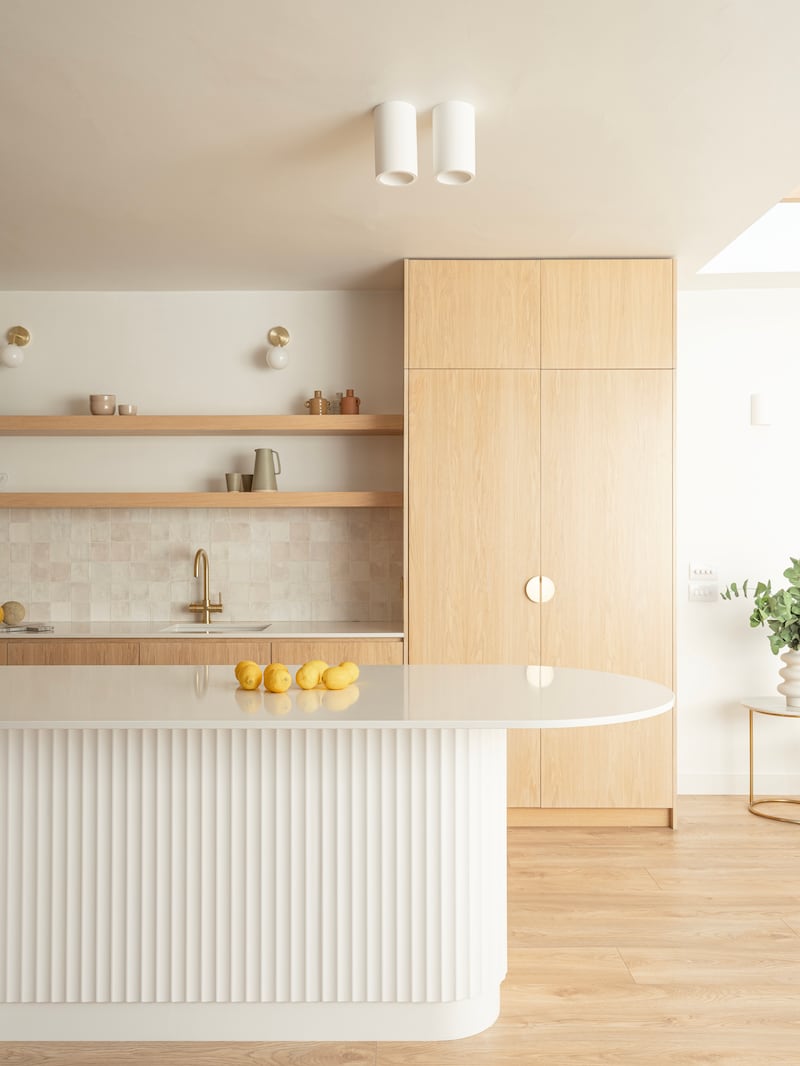
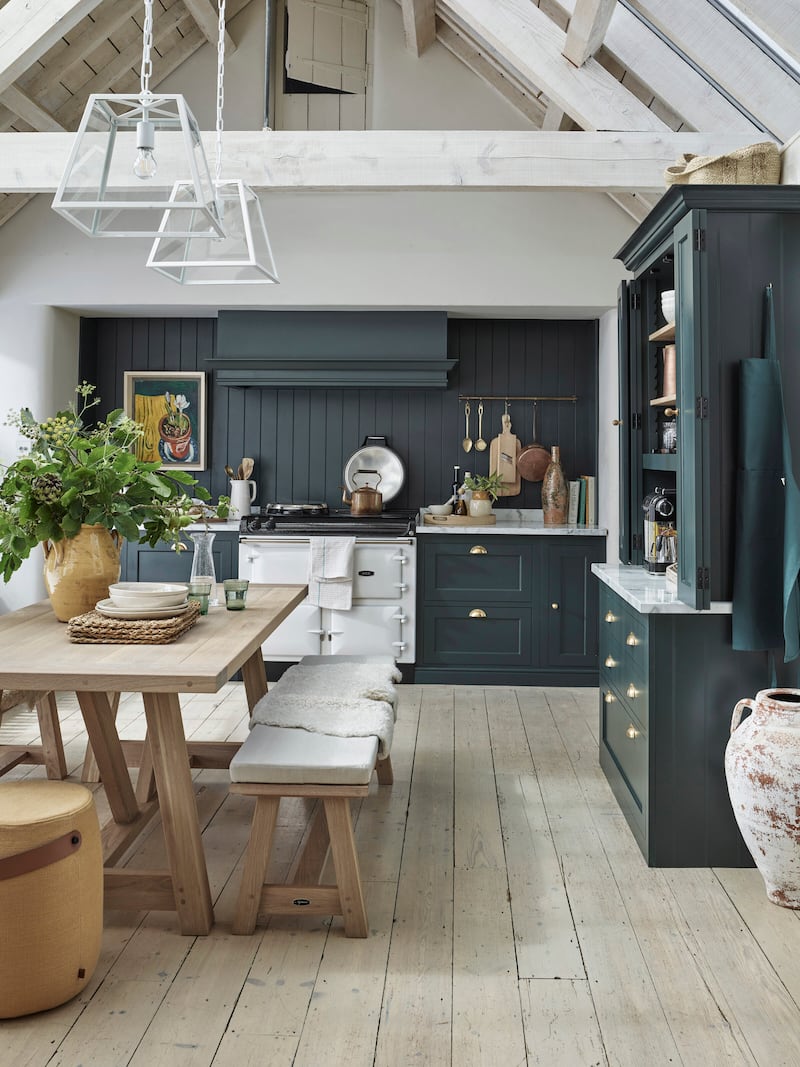
If you want an island, make sure you have enough space for it, says McDonnell. A distance of 1.1m between wall cabinets and where an island begins will enable proper circulation, she advises.
· An island less than 2m in length may prove too cramped for seating, eating and food prep, says McDonnell. A size of 2.5m or 3m is optimal. “This will have enough space to maybe put your dishwasher into it or proper storage without it feeling like it’s eating into your space.”
· Sink or hob? An island without either of these is optimal, says McDonnell. “Then it becomes the perfect area for serving a buffet, or as a nice gathering spot.” If it’s a toss up between the sink and hob, the hob is the better option, says McDonnell.
· “Most people use their island for chopping and prepping food, so it’s a natural space to use as a cooking station,” says McDonnell. “Visually a hob blends in a bit better on the island too. Downdraft extractors mean you don’t have an ugly extractor coming down.”
· Position kitchen elements to match your workflow. “Below your sink, to the left and right, have your bin drawer and your dishwasher. That’s where you will need them to be when you are clearing up after dinner,” says McDonnell.
· Wondering where to put the fridge? “I think the fridge should be away from where you are prepping food and cooking,” says McDonnell. “Never have your fridge opposite your sink or hob, because if somebody is at the fridge, there could be two people back to back. A fridge is always better on a wall perpendicular to where you have your prep space, sink or hob so the door isn’t swinging back.”
· Investing in an outdoor kitchen and dining area? Check the light. If your garden orientation means that space is mostly in shade, you may not use it as much as you think you will. “Think about what time of day you are going to be using the space and figure out where the light is,” says McDonnell. “We do a lot of north-facing extensions and we are landscaping the garden where there is a patch of sun down the very end of the garden because the sun trap is happening down there.”
· If you are opting for overhead cabinets, run them up to the ceiling – otherwise that space becomes a dust-filled dumping ground. Using a uniform flooring across the entire kitchen/dining space will make it appear bigger and more unified.
- Sign up for push alerts and have the best news, analysis and comment delivered directly to your phone
- Find The Irish Times on WhatsApp and stay up to date
- Our In The News podcast is now published daily – Find the latest episode here










